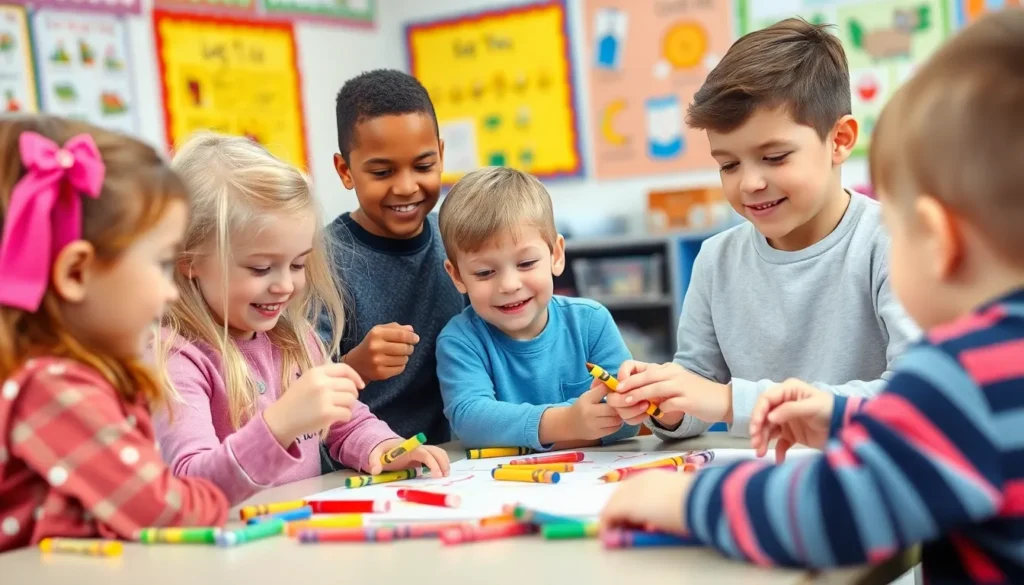Table of Contents
ToggleNavigating the world of preschool can be both exciting and challenging for young children. As they embark on this journey of learning and social interaction, developing patience becomes a crucial skill. Preschool patience isn’t just about waiting; it’s about understanding, sharing, and growing alongside peers.
In a bustling classroom filled with diverse personalities and activities, children learn to manage their emotions and expectations. This foundational skill not only fosters better relationships with classmates but also sets the stage for lifelong learning. As parents and educators, recognizing the importance of nurturing patience in preschoolers can lead to a more harmonious and enriching educational experience.
Understanding Preschool Patience
Preschool patience plays a vital role in a child’s development during early education. This skill enhances their interactions and emotional regulation within a classroom setting.
Defining Preschool Patience
Preschool patience involves more than waiting; it encompasses understanding others, sharing experiences, and growing alongside peers. Children learn to take turns, listen, and express their feelings in a healthy manner. These behaviors contribute to a supportive environment where collaborative learning thrives.
Importance of Patience in Early Childhood
Patience in early childhood fosters emotional intelligence and social skills. Children who practice patience improve their ability to cope with challenges, such as frustration or delays. A study by the American Academy of Pediatrics highlights that mastering patience strengthens relationships and promotes better conflict resolution. Additionally, developing this skill enhances cognitive outcomes, making learning more effective and enjoyable.
Factors Affecting Preschool Patience

Various elements influence preschool patience, shaping how children interact and manage their emotions in different situations. Understanding these factors is crucial for fostering patience effectively.
Individual Differences
Individual differences play a significant role in preschool patience levels. Age affects patience, as younger children typically exhibit shorter attention spans compared to older peers. Personality traits also contribute; children with temperament profiles characterized by high emotionality may struggle more with delays. Social skills, including empathy and impulse control, further define a child’s ability to wait and share appropriately. For instance, children familiar with cooperative play often demonstrate higher patience as they navigate interactions.
Environmental Influences
Environmental influences significantly impact children’s patience development. Classroom settings that promote structured routines foster predictability, allowing children to learn waiting skills. Positive reinforcement, such as praise or rewards, further encourages patience. Parental involvement contributes as well; children exposed to modeling of patient behavior at home develop similar traits. Social dynamics also matter; peers who practice sharing and taking turns create a culture of patience within the classroom. Moreover, availability of resources, such as toys and learning materials, influences how children learn to manage waiting times in social situations.
Strategies to Foster Patience in Preschoolers
Fostering patience in preschoolers involves integrating specific activities and approaches within their learning environment. Various strategies can enhance their ability to wait and develop emotional regulation.
Activities to Encourage Waiting
Engaging preschoolers in activities that naturally require waiting can effectively build their patience. Examples include:
- Board Games: Games that involve turn-taking help children practice waiting for their turn while enjoying each other’s company.
- Simon Says: This game encourages children to listen and follow directions patiently, enhancing their waiting skills.
- Snack Time Sharing: Children can take turns choosing snacks, making the waiting aspect more engaging.
- Craft Projects: Collaborative art activities often require waiting for each other, teaching children to appreciate the process.
Each of these activities reinforces the importance of patience in a fun and interactive manner.
Role of Educators and Parents
Educators and parents play a vital role in cultivating patience in preschoolers. Their influence can shape children’s understanding and practice of this essential skill. Key strategies include:
- Modeling Behavior: Demonstrating patience in everyday situations encourages children to emulate these behaviors.
- Positive Reinforcement: Acknowledging and rewarding moments of patience helps reinforce the behavior.
- Structured Routines: Establishing consistent schedules creates a predictable environment, helping children learn when to expect transitions and wait times.
- Encouragement of Empathy: Teaching children to recognize and respect peers’ feelings fosters a deeper understanding of patience, enhancing their ability to wait.
Through these strategies, adults contribute significantly to the development of patience in preschoolers, preparing them for future interactions and challenges.
Benefits of Developing Patience in Preschoolers
Developing patience in preschoolers offers numerous benefits that enhance their ability to learn and interact. Such growth in various areas translates to a more enriching educational experience.
Social Skills Development
Patience plays a critical role in social skills development among preschoolers. Children who cultivate patience learn to take turns during games and share toys with peers, fostering cooperation. Engaging in group activities allows children to practice active listening, which strengthens their communication abilities. Children who demonstrate patience contribute to a positive classroom atmosphere, creating friendships rooted in understanding and mutual respect.
Emotional Regulation
Building patience equips preschoolers with essential emotional regulation skills. Children learn to manage frustration when they encounter waiting periods or when things don’t go as planned. This ability reduces tantrums and increases resilience, enabling children to cope better with life’s challenges. By practicing patience, they learn to express their feelings in healthy ways, promoting a greater sense of self-awareness and emotional intelligence.
Fostering preschool patience is crucial for children’s emotional and social development. By nurturing this skill, parents and educators create a foundation for healthier interactions and better emotional regulation. Engaging preschoolers in activities that require waiting and sharing not only enhances their patience but also enriches their overall learning experience.
As children practice patience, they build essential skills that will serve them well throughout their lives. This journey of developing patience shapes their ability to cope with challenges and fosters resilience. Ultimately, patience is more than just waiting; it’s about understanding and growing together, paving the way for meaningful relationships and a positive learning environment.







